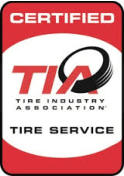










© Ozarko Tire Centers, Inc.


SAFETY


Ozarko Tire Centers is Committed to Safety
We strive at keeping our employees safe as well as the vendors and customers we work with. It’s important to us that everyone knows that safety comes first.Our Safety Challenge
• Maintain compliance to all local, state and federal safety rules and regulation • Take steps to help eliminate any work related injuries • Provide awareness of safe work practices and work safety issues • Help employees overcome potential safety hazards Employee Responsibility • Wear Protective equipment when required • Follow established safe work procedures • Alert your supervisor of any unsafe practices or conditions • Comply to all safety regulations and policies TIA Certified for Commercial Tire Service • Safety - Includes personal protective equipment, lifting safety, and other topics like heat stoke and frostbite • Basic Tire Info - Addresses tire construction, sizing and nomenclature, inflation pressure, tread design and compound for different applications, speed rating and all special service ratings and identification. • Rims and Wheels - Outlines the difference between rims and wheels including the nomenclature for both assemblies. It will also identify and address the different type of hub aand drum assemblies for commercial vehicles. • OSHA Regulations - Includes the script of the OSHA Regulations 29 CFR 1910.177. • Jacking and Lifting - outlines procedures for properly jacking, lifting and supporting trucks, tractors and trailers. It will focus on jack and jack stand identification and operation as well as the proper position of each when lifting one. two, or three axles. • Torque - Defines the relationship between torque and clamping force when installing wheels and rims. This indepth look at how tightening a fastener creates the force that holds the assemblies to the vehicles will help technicians understand the importance of the RIST procedure (Remove Debris, Inspect components, Snug in a star, Torque to spec). • Wheel End Safety - Addresses wheel end tires, commercial vehicle inspection, wheel- off prevention, and wheel end maintenance. • Hub-Pilot Wheels - Puts the basic principles of the previous two headings to work with hub-pilot wheel removal as well as the inspection and installation guidelines that accompany the RIST procedure • Stud Pilot Wheels - Focuses on stud-pilot wheel removal as well as the inspection and installation guidelines that accompany the RIST procedures • Demountable Rims - Addresses demountable rim removal as well as the inspection and installation guidelines that accompany the RIST procedures. • Single-Piece - Dedicated to single-piece demount, mount and inflation procedures with an increased emphasis on disc wheel inspection, valve stem installation (including torque) and concentric bead seating techniques. • Multi Piece - Covers the basics for demounting, mounting and inflating two-piece and three-piece multi-piece assemblies.






Ozarko Tire Centers is Committed to
Safety
We strive at keeping our employees safe as well as the vendors and customers we work with. It’s important to us that everyone knows that safety comes first.Our Safety Challenge
• Maintain compliance to all local, state and federal safety rules and regulation • Take steps to help eliminate any work related injuries • Provide awareness of safe work practices and work safety issues • Help employees overcome potential safety hazardsEmployee Responsibility
• Wear Protective equipment when required • Follow established safe work procedures • Alert your supervisor of any unsafe practices or conditions • Comply to all safety regulations and policiesTIA Certified for Commercial Tire Service
• Safety - Includes personal protective equipment, lifting safety, and other topics like heat stoke and frostbite • Basic Tire Info - Addresses tire construction, sizing and nomenclature, inflation pressure, tread design and compound for different applications, speed rating and all special service ratings and identification. • Rims and Wheels - Outlines the difference between rims and wheels including the nomenclature for both assemblies. It will also identify and address the different type of hub aand drum assemblies for commercial vehicles. • OSHA Regulations - Includes the script of the OSHA Regulations 29 CFR 1910.177. • Jacking and Lifting - outlines procedures for properly jacking, lifting and supporting trucks, tractors and trailers. It will focus on jack and jack stand identificationand operation as well as the proper position of each when lifting one. two, or three axles. • Torque - Defines the relationship between torque and clamping force when installing wheels and rims. This indepth look at how tightening a fastener creates the force that holds the assemblies to the vehicles will help technicians understand the importance of the RIST procedure (Remove Debris, Inspect components, Snug in a star, Torque to spec). • Wheel End Safety - Addresses wheel end tires, commercial vehicle inspection, wheel-off prevention, and wheel end maintenance. • Hub-Pilot Wheels - Puts the basic principles of the previous two headings to work with hub-pilot wheel removal as well as the inspection and installation guidelines that accompany the RIST procedure • Stud Pilot Wheels - Focuses on stud-pilot wheel removal as well as the inspection and installation guidelines that accompany the RIST procedures • Demountable Rims - Addresses demountable rim removal as well as the inspection and installation guidelines that accompany the RIST procedures. • Single-Piece - Dedicated to single-piece demount, mount and inflation procedures with an increased emphasis on disc wheel inspection, valve stem installation (including torque) and concentric bead seating techniques. • Multi Piece - Covers the basics for demounting, mounting and inflating two-piece and three-piece multi- piece assemblies.

SAFETY








